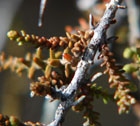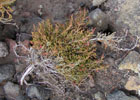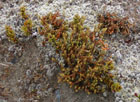
Ripe seed and epimatium of wild plant in Mangotepopo shrubland, Tongariro Crossing [C.J. Earle, 2003.03.07].

Foliage of wild plant in Mangotepopo shrubland [C.J. Earle, 2003.03.07].

A shrub 15 cm tall and 20 cm across - old, for this species. On Mangotepopo shrubland [C.J. Earle, 2003.03.07].

Plant about 20 cm across growing in cushion tundra, Tongariro Crossing, below North Crater [C.J. Earle, 2003.03.07].

Stand of Lepidothamnus growing with Hebe, Tongariro Crossing [C.J. Earle, 2003.03.07].

L. laxifolius: seed erect, ovoid, smooth, rounded, brown-black; micropyle sharply reflexed, distinct, epimatium thinly fleshy, pink-red; cone bracts swollen, fused, thickly fleshy, pink-red: cone 8 mm × 5 mm [J.H. Johns] (Molloy 1995).

Conservation Status

Lepidothamnus laxifolius
(Hook. f.) C.J. Quinn 1982
Common names
Mountain rimu, pigmy pine, pygmy pine.
Taxonomic notes
Syn: Dacrydium laxifolium Hooker f. 1845 (Quinn 1982). See Dacrydium for details. Type locality: Mount Tongariro (Allan 1961).
Description
A prostrate or sub-erect shrub with slender trailing branches c. 2-5 mm in diameter and up to 1 m or more long. Leaves of juvenile plants lax, spreading, narrow-linear, acute, flat, curved, 5-12 mm long, passing gradually into the adult leaves, which are linear-oblong, blunt or sub-acute, 1-2 mm long, appressed, imbricate, oblong-ovate, obtuse, keeled; scale-like. Branchlets often have a a mixture of leaf forms. Plants often monoecious. Pollen cones are solitary, terminal, sessile, up to 8 mm long, the apiculus broadly triangular, acute. Ovule solitary, terminal; receptacle swollen, crimson, succulent, rarely dry. Seed 3-5 mm. long, nutlike, oblong-cylindrical, obtuse, with stout, curved apiculus far exserted beyond epimatium. Aril red (Allan 1961, Dallimore et al. 1967).
Distribution and Ecology
New Zealand: N, S and Stewart Is. Montane and subalpine scrub and moorland from lat. 39° southwards; also lowland in Stewart Island (Allan 1961). Also occurs in alpine scrub, often as a trailing shrub on steep slopes (pers. obs., Tongariro National Park, 2003.03.07). Mean elevation for 123 collection sites was 682 m, with a mean annual temperature of 9.0°C and an average minimum in the coldest month of -0.5°C, and a mean annual precipitation of 3098 mm (Biffin et al. 2011, Table S5). Hardy to Zone 7 (cold hardiness limit between -17.7°C and -12.2°C) (Bannister and Neuner 2001).
Remarkable Specimens
I have no data on large specimens. This is one of the smallest known conifers. Kirk (1889) says that "fruiting specimens may sometimes be found less than 2 in. [5 cm] in height". Only Juniperus horizontalis is smaller; in that species, cone-bearing specimens only 4 cm tall have been found.
Ethnobotany
See Conifers of New Zealand for a review of the historic role of forests in native and European cultures of New Zealand. I have no specific information on use of this species.
Observations
I have seen it in New Zealand's Tongariro National Park. Some plants can be seen growing in alpine scrub in close association with Halocarpus bidwillii and Podocarpus nivalis and along both the east and north ends of the Tongariro Crossing, along the Silica Rapids and Taranaki Falls walks starting at Whakapapa Village on Mount Ruapehu.
Remarks
Citations
Allan, H. H. 1961. Flora of New Zealand. Volume I, Indigenous Tracheophyta. Wellington: R.E. Owen Government Printer.
See also
The New Zealand Plant Conservation Network, accessed 2010.11.22.
Kirk, T. 1877. A revised Arrangement of the New Zealand Species of Dacrydium, with Descriptions of new Species. Transactions and Proceedings of the Royal Society of New Zealand 10:383-391 (as Dacrydium laxifolium; accessed 2011.03.27).






